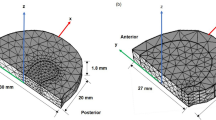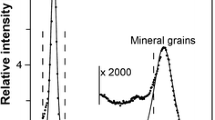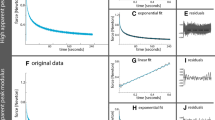Abstract
Purpose
Aggrecan is one of the major macromolecular components of the intervertebral disc (IVD) and its loss is an early sign of degeneration. Restoration of aggrecan, and hence of biomechanical properties, is a major objective of biological therapies. At present, assessment of aggrecan concentration via its glycosaminoglycan (GAG) content is accomplished using biochemical and histological methods which require sacrifice of tissue. A minimally invasive method for assessing GAG, and hence aggrecan, which can avoid destruction of tissue, would be of benefit.
Methods
We have developed a needle micro-osmometer that is capable of measuring flux of saline into excised human nucleus pulposus (NP) tissue. Using the isotropic osmotic stress technique to assess the swelling pressure of the excised NP tissue and assuming negligible collagen tensile stress, we were able to relate the flux to the tissue fixed charge density (FCD). GAG concentration is evaluated from its FCD via the radioactive tracer technique. Samples representing different ages (28–59 years) and degeneration grades (1–4) were analyzed.
Results
The flux is controlled by both the osmotic pressure difference across the probe’s semi-permeable membrane and by the tissue permeability. A linear correlation was found between flux and the tissue FCD. The equation describing the linear fit is FCD/(total tissue hydration) = 1.97 × 10−4 + 8283 × flux (R = 0.836, p < 10−4). Thus, by measuring saline flux, the concentration of GAG can be determined.
Conclusions
Micro-osmometry provides a reliable and minimally invasive tool for assessing GAG content in excised NP tissue. This method may be usefully applied in tissue engineering applications. It may also be useful for in vivo measurements if the question of the degenerative effect of needle puncture can be overcome.





Similar content being viewed by others
References
Urban J, Maroudas A (1980) The chemistry of the intervertebral disc in relation to its physiological function. Clin Rheum Dis 6:51–76
Maroudas A, Thomas H (1970) A simple physicochemical micromethod for determining fixed anionic groups in connective tissue. Biochim Biophys Acta 215:214–216
Maroudas A (1973) Physico-chemical properties of articular cartilage. In: Freeman MAR (ed) Adult articular cartilage, 2nd edn. Pitman Medical, London, pp 131–170
Broom ND, Marra DL (1985) New structural concepts of articular cartilage demonstrated with a physical model. Connect Tissue Res 14:1–8
Maroudas A, Urban J (1980) Swelling pressure of cartilaginious tissues. In: Maroudas A, Holborow EJ (eds) Studies in joint diseases. Pitman Medical, London
Nachemson A, Morris JM (1964) In vivo measurements of intradiscal pressure. Discometry, a method for the determination of pressure in the lower lumbar discs. J Bone Joint Surg Am 46:1077–1092
Wilke H, Neef P, Hinz B et al (2001) Intradiscal pressure together with anthropometric data—a data set for the validation of models. Clin Biomech (Bristol, Avon) 16((Suppl 1):):S111–S126
Wilke HJ, Neef P, Caimi M et al (1999) New in vivo measurements of pressures in the intervertebral disc in daily life. Spine (Phila Pa 1976) 24:755–762
Urban JP, Maroudas A, Bayliss MT et al (1979) Swelling pressures of proteoglycans at the concentrations found in cartilaginous tissues. Biorheology 16:447–464
Lyons G, Eisenstein SM, Sweet MB (1981) Biochemical changes in intervertebral disc degeneration. Biochim Biophys Acta 673:443–453
Basser PJ, Schneiderman R, Bank RA et al (1998) Mechanical properties of the collagen network in human articular cartilage as measured by osmotic stress technique. Arch Biochem Biophys 351:207–219
Erlich S, Wolff N, Schneiderman R et al (1998) The osmotic pressure of chondroitin sulphate solutions: experimental measurements and theoretical analysis. Biorheology 35:383–397
Williams RP, Comper WD (1990) Osmotic flow caused by polyelectrolytes. Biophys Chem 36:223–234
Morgan S, Saifuddin A (1999) MRI of the lumbar intervertebral disc. Clin Radiol 54:703–723
Luoma K, Vehmas T, Riihimaki H et al (2001) Disc height and signal intensity of the nucleus pulposus on magnetic resonance imaging as indicators of lumbar disc degeneration. Spine (Phila Pa 1976) 26:680–686
Bashir A, Gray ML, Hartke J et al (1999) Nondestructive imaging of human cartilage glycosaminoglycan concentration by MRI. Magn Reson Med 41:857–865
Shapiro EM, Borthakur A, Gougoutas A et al (2002) 23Na MRI accurately measures fixed charge density in articular cartilage. Magn Reson Med 47:284–291
Wheaton AJ, Borthakur A, Shapiro EM et al (2004) Proteoglycan loss in human knee cartilage: quantitation with sodium MR imaging—feasibility study. Radiology 231:900–905
Ibrahim MA, Jesmanowicz A, Hyde JS et al (1994) Contrast enhancement of normal intervertebral disks: time and dose dependence. AJNR Am J Neuroradiol 15:419–423
Johannessen W, Auerbach JD, Wheaton AJ et al (2006) Assessment of human disc degeneration and proteoglycan content using T1rho-weighted magnetic resonance imaging. Spine (Phila Pa 1976) 31:1253–1257
Farndale RW, Buttle DJ, Barrett AJ (1986) Improved quantitation and discrimination of sulphated glycosaminoglycans by use of dimethylmethylene blue. Biochim Biophys Acta 883:173–177
Pfirrmann CW, Metzdorf A, Zanetti M et al (2001) Magnetic resonance classification of lumbar intervertebral disc degeneration. Spine (Phila Pa 1976) 26:1873–1878
Urban JP, McMullin JF (1985) Swelling pressure of the inervertebral disc: influence of proteoglycan and collagen contents. Biorheology 22:145–157
Sivan S, Merkher Y, Wachtel E et al (2006) Correlation of swelling pressure and intrafibrillar water in young and aged human intervertebral discs. J Orthop Res 24:1292–1298
Maroudas A, Wachtel E, Grushko G et al (1991) The effect of osmotic and mechanical pressures on water partitioning in articular cartilage. Biochim Biophys Acta 1073:285–294
Maroudas A, Grushko G (1990) Measurements of swelling pressure of cartilage. In: Maroudas A, Kuettner K (eds) Methods in cartilage research, 2nd edn. Academic Press, London, pp 298–301
Parsegian VA, Rand RP, Fuller NL et al (1986) Osmotic stress for the direct measurement of intermolecular forces. Methods Enzymol 127:400–416
Urban JP, Maroudas A (1981) Swelling of the intervertebral disc in vitro. Connect Tissue Res 9:1–10
Wachtel E, Maroudas A (1998) The effects of pH and ionic strength on intrafibrillar hydration in articular cartilage. Biochim Biophys Acta 1381:37–48
Urban JP, Maroudas A (1979) The measurement of fixed charged density in the intervertebral disc. Biochim Biophys Acta 586:166–178
Urban J, Maroudas A (1980) Meausurements of swelling pressure and fluid flow in the intervertebral disc with reference to creep. Proc Inst Mech Eng 2:63–69
Levick JR (1987) Flow through interstitium and other fibrous matrices. Q J Exp Physiol 72:409–437
Wilke HJ, Wolf S, Claes LE et al (1996) Influence of varying muscle forces on lumbar intradiscal pressure: an in vitro study. J Biomech 29:549–555
Maroudas A, Bayliss MT, Venn MF (1980) Further studies on the composition of human femoral head cartilage. Ann Rheum Dis 39:514–523
Wang JL, Tsai YC, Wang YH (2007) The leakage pathway and effect of needle gauge on degree of disc injury post anular puncture: a comparative study using aged human and adolescent porcine discs. Spine (Phila Pa 1976) 32:1809–1815
Michalek AJ, Funabashi KL, Iatridis JC (2010) Needle puncture injury of the rat intervertebral disc affects torsional and compressive biomechanics differently. Eur Spine J 19:2110–2116
Hsieh AH, Hwang D, Ryan DA et al (2009) Degenerative anular changes induced by puncture are associated with insufficiency of disc biomechanical function. Spine (Phila Pa 1976) 34:998–1005
Carragee EJ, Don AS, Hurwitz EL et al (2009) 2009 ISSLS Prize Winner: does discography cause accelerated progression of degeneration changes in the lumbar disc: a ten-year matched cohort study. Spine (Phila Pa 1976) 34:2338–2345
Michalek AJ, Buckley MR, Bonassar LJ et al (2010) The effects of needle puncture injury on microscale shear strain in the intervertebral disc annulus fibrosus. Spine J 10:1098–1105
Bron JL, Helder MN, Meisel HJ et al (2009) Repair, regenerative and supportive therapies of the annulus fibrosus: achievements and challenges. Eur Spine J 18:301–313
Omlor GW, Bertram H, Kleinschmidt K et al (2010) Methods to monitor distribution and metabolic activity of mesenchymal stem cells following in vivo injection into nucleotomized porcine intervertebral discs. Eur Spine J 19:601–612
Omlor GW, Nerlich AG, Lorenz H et al (2012) Injection of a polymerized hyaluronic acid/collagen hydrogel matrix in an in vivo porcine disc degeneration model. Eur Spine J 21:1700–1708
Acknowledgments
The authors would like to thank Prof. Peter-Paul Varga from the National Center for Spinal Disorders (Budapest, Hungary) and Prof. Marco Brayda-Bruno from the Galeazzi Orthopaedic Institute (Milan, Italy) for providing MRI-graded IVD samples. The research leading to these results has received funding from the European Community’s Seventh Framework Programme (FP7, 2007-2013) under Grant agreement no. HEALTH-F2-2008-201626. The partial financial support from the FP7-People-2007-2-2-ERG (Grant agreement 224834) is gratefully acknowledged (S.S). We acknowledge the support from the Charles W. McCutchen Foundation (A.M. and Y.M.).
Conflict of interest
None.
Author information
Authors and Affiliations
Corresponding author
Rights and permissions
About this article
Cite this article
Sivan, S.S., Merkher, Y., Wachtel, E. et al. A needle micro-osmometer for determination of glycosaminoglycan concentration in excised nucleus pulposus tissue. Eur Spine J 22, 1765–1773 (2013). https://doi.org/10.1007/s00586-013-2714-8
Received:
Revised:
Accepted:
Published:
Issue Date:
DOI: https://doi.org/10.1007/s00586-013-2714-8




